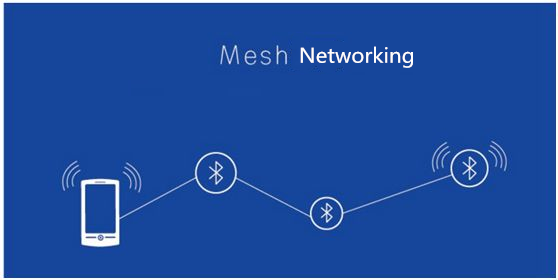The new Mesh technology can support many-to-many transmission of devices, and allows all devices compatible with the standard to talk to each other at a certain distance at the same time, and also improves the communication efficiency of building a wide range of network coverage.
* Three types of nodes forming the basic service set of wireless mesh networks *
1. The node (GateWay node) connected to the wired network is mainly responsible for data exchange between the wireless mesh network and the wired network.
2. A STA (Station) that can perform Mesh networking and has a routing function. It also has the characteristics of a terminal STA and a router, that is, it can obtain the services provided by the Mesh network itself and can also perform data routing and forwarding for other STAs.
3. Nodes that accept Mesh services but do not have Mesh and Routing functions are called terminal STAs.

* Three Basic Types of Mesh Network Structure *
1. Pure mesh network: The mesh network is isolated, and all services are within the mesh network;
2. Hybrid Mesh Network: There is another network superimposed on the Mesh network. The backbone router is introduced to improve efficiency and specifically transmit long-distance services;
3. Access Mesh Network: like gateway.
* Mesh VS other networks *
1. From the perspective of topology, WLAN is a typical point-to-multipoint (P2MP) network, and it uses a single-hop method, so data cannot be forwarded.
2. Both WMN and Ad-Hoc networks are point-to-point (P2P) self-organized multi-hop networks. WMNs focus on "wireless", while mobile Ad-Hoc networks focus on "mobile". From the application point of view, WMN is mainly used for access to the Internet or broadband multimedia communication services, and mobile Ad-Hoc networks are mainly used for military or other professional communications.

* Mesh Network Extension Knowledge *
1. Relay throughput is not the main limiting factor for average throughput. Interference is the main factor limiting average throughput. But frequency hopping is one way to avoid interference.
2. In Mesh networks, user mobility may lead to greater compromises in efficiency and availability than current cellular systems. This is because Mesh users are also system routing nodes.
3. The architecture design of the wireless system must assume from the beginning that a specific frequency spectrum has been allocated to a specific application.
* Bluetooth Mesh technology makes up for short network *
BLE Bluetooth has a better signal-to-noise ratio and longer transmission distance than traditional Bluetooth, and has low power consumption (power saving) and small data transmission (but fast speed). Nevertheless, the application of BLE Bluetooth in the fields of intelligent lighting still has shortcomings such as short distances and poor networking capabilities.
Limited by the shortcomings of networking, the advantages of Bluetooth in some applications of the smart home are relatively weak. However, due to the introduction of Mesh technology, the shortcomings of Bluetooth networking have been made up, and the distance has been extended, making BLE Bluetooth's application status in smart homes increasing.
It is worth mentioning that the Mesh network uses the Bluetooth technology to broadcast. It can transmit data without requiring a connection. For example, iBeacon launched by Apple using the characteristics of Bluetooth broadcast, the content and transmission method of the broadcast can be customized, and it can also be combined with business, such as product information push.


